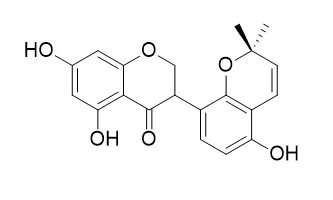| In vitro: |
| Chinese Traditional and Herbal Drugs, 2016. | | Study on active constituents from Glycyrrhizae Radix et Rhizoma against NO production in LPS-induced RAW264.7 macrophages.[Reference: WebLink] | To study the anti-inflammatory constituents in Glycyrrhizae Radix et Rhizoma.
METHODS AND RESULTS:
The compounds were isolated and purified by means of macroporous resin, ODS column chromatography, and semi-preparative HPLC. And their structures were identified by LC-MS, 1H-NMR, and 13C-NMR. The anti-inflammatory activities of the compounds were evaluated on LPS-induced NO production in RAW 264.7 macrophages.Their structures were identified as liquiritin(1), liquiritin apioside(2), isoliquiritin(3), isoliquiritin apioside(4), sophoraisoflavone A(5), Glyasperin F(6), glabrone(7), glabridin(8), licoflavonol(9), and glyasperin D(10).
CONCLUSIONS:
Compounds 1, 3, 5, 6, 8, and 9 could inhibit NO production in RAW 264.7 macrophages to some extent. And the anti-inflammatory effects of compounds 5, 6, and 9 are first reported in this work. | | Bmc Complementary & Alternative Medicine, 2018, 18(1):36. | | Cytotoxicity of seputhecarpan D, thonningiol and 12 other phytochemicals from African flora towards human carcinoma cells.[Reference: WebLink] | Despite the remarkable progress in cancer therapy in recent years, this disease still remains a serious public health concern. The use of natural products has been and continues to be one of the most effective ways to fight malignancies. The cytotoxicity of 14 compounds from African medicinal plants was evaluated in four human carcinoma cell lines and normal fibroblasts.
The tested samples included: β-spinasterol (1), friedelanone (2), 16β-hydroxylupeol (3), β-amyrin acetate (4), lupeol acetate (5), sequoyitol (6), rhamnitrin (7), europetin 3-O-rhamnoside (8), thonningiol (9), Glyasperin F (10), seputhecarpan B (11), seputhecarpan C (12), seputhecarpan D (13) and rheediaxanthone A (14).
METHODS AND RESULTS:
The neutral red uptake (NR) assay was used to evaluate the cytotoxicity of samples; caspase-Glo assay, flow cytometry for cell cycle analysis and mitochondrial membrane potential (MMP) as well as spectrophotometry to measure levels of reactive oxygen species (ROS) were performed to detect the mode of action of compounds 9 and 13 in MCF-7 breast adenocarcinoma cells.Compounds 3, 9-13 displayed cytotoxic effects against the four tested cancer cell lines with IC50values below 85 μM. Compounds 9 and 13 had IC50values below 10 μM in 4/4 and 3/4 tested cell lines respectively. The IC50values varied from 0.36 μM (against MCF7 cells) to 5.65 μM (towards colon carcinoma DLD-1 cells) for 9, from 9.78 μM (against MCF7 cells) to 67.68 μM (against HepG2 cells) for 13 and 0.18 μM (towards HepG2 cells) to 72 μM (towards Caco-2 cells) for the reference drug, doxorubicin. Compounds 9 and 13 induced cell cycle arrest in Go/G1 whilst doxorubicin induced arrest in G2/M. The two molecules (9 and 13) also induced apoptosis in MCF-7 cells through activation of caspases 3/7 and 9 as well as enhanced ROS production.
CONCLUSIONS:
Compounds 9 and 13 are good cytotoxic phytochemicals that should be explored more in future to develop a cytotoxic drug to fight human carcinoma. | | Bmc Complementary & Alternative Medicine, 2018, 18(1):36. | | Cytotoxicity of seputhecarpan D, thonningiol and 12 other phytochemicals from African flora towards human carcinoma cells.[Reference: WebLink] | Despite the remarkable progress in cancer therapy in recent years, this disease still remains a serious public health concern. The use of natural products has been and continues to be one of the most effective ways to fight malignancies. The cytotoxicity of 14 compounds from African medicinal plants was evaluated in four human carcinoma cell lines and normal fibroblasts.
The tested samples included: β-spinasterol (1), friedelanone (2), 16β-hydroxylupeol (3), β-amyrin acetate (4), lupeol acetate (5), sequoyitol (6), rhamnitrin (7), europetin 3-O-rhamnoside (8), thonningiol (9), Glyasperin F (10), seputhecarpan B (11), seputhecarpan C (12), seputhecarpan D (13) and rheediaxanthone A (14).
METHODS AND RESULTS:
The neutral red uptake (NR) assay was used to evaluate the cytotoxicity of samples; caspase-Glo assay, flow cytometry for cell cycle analysis and mitochondrial membrane potential (MMP) as well as spectrophotometry to measure levels of reactive oxygen species (ROS) were performed to detect the mode of action of compounds 9 and 13 in MCF-7 breast adenocarcinoma cells.Compounds 3, 9-13 displayed cytotoxic effects against the four tested cancer cell lines with IC50values below 85 μM. Compounds 9 and 13 had IC50values below 10 μM in 4/4 and 3/4 tested cell lines respectively. The IC50values varied from 0.36 μM (against MCF7 cells) to 5.65 μM (towards colon carcinoma DLD-1 cells) for 9, from 9.78 μM (against MCF7 cells) to 67.68 μM (against HepG2 cells) for 13 and 0.18 μM (towards HepG2 cells) to 72 μM (towards Caco-2 cells) for the reference drug, doxorubicin. Compounds 9 and 13 induced cell cycle arrest in Go/G1 whilst doxorubicin induced arrest in G2/M. The two molecules (9 and 13) also induced apoptosis in MCF-7 cells through activation of caspases 3/7 and 9 as well as enhanced ROS production.
CONCLUSIONS:
Compounds 9 and 13 are good cytotoxic phytochemicals that should be explored more in future to develop a cytotoxic drug to fight human carcinoma. |
|






 Cell. 2018 Jan 11;172(1-2):249-261.e12. doi: 10.1016/j.cell.2017.12.019.IF=36.216(2019)
Cell. 2018 Jan 11;172(1-2):249-261.e12. doi: 10.1016/j.cell.2017.12.019.IF=36.216(2019) Cell Metab. 2020 Mar 3;31(3):534-548.e5. doi: 10.1016/j.cmet.2020.01.002.IF=22.415(2019)
Cell Metab. 2020 Mar 3;31(3):534-548.e5. doi: 10.1016/j.cmet.2020.01.002.IF=22.415(2019) Mol Cell. 2017 Nov 16;68(4):673-685.e6. doi: 10.1016/j.molcel.2017.10.022.IF=14.548(2019)
Mol Cell. 2017 Nov 16;68(4):673-685.e6. doi: 10.1016/j.molcel.2017.10.022.IF=14.548(2019)